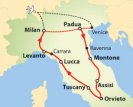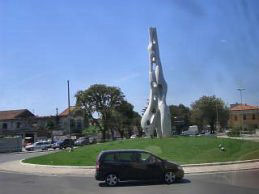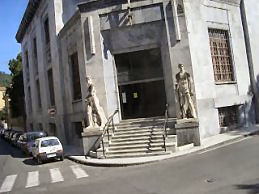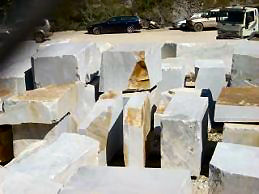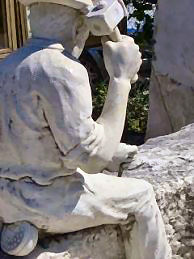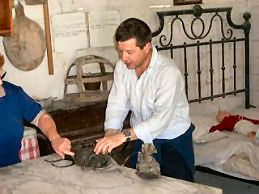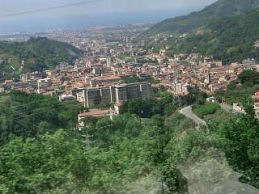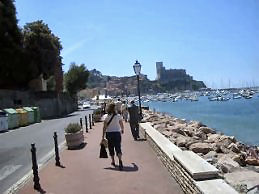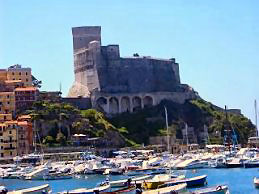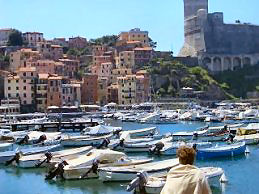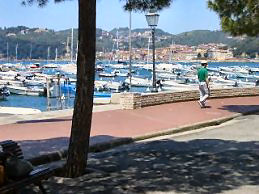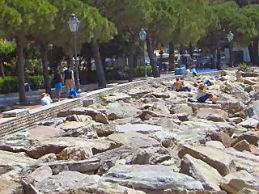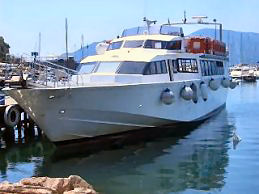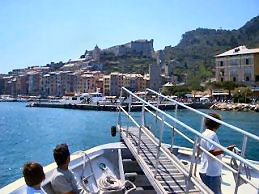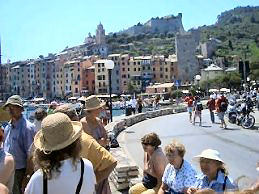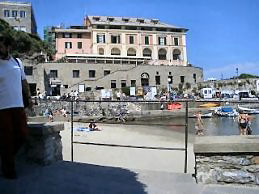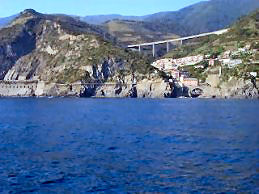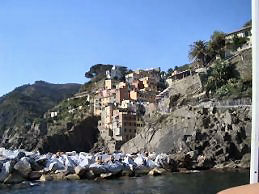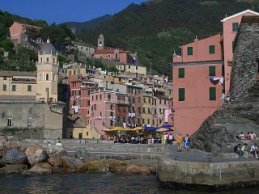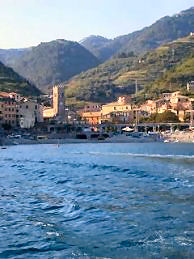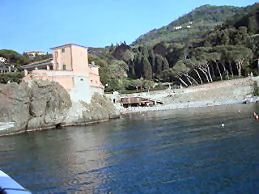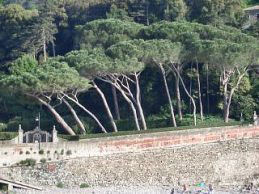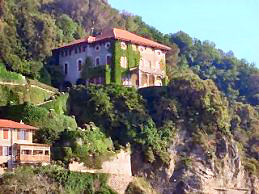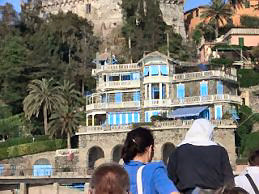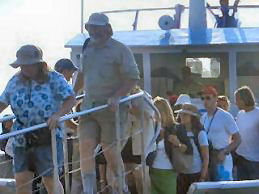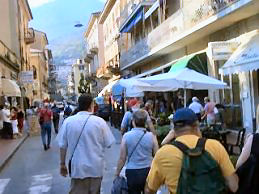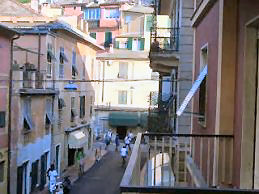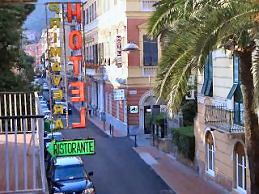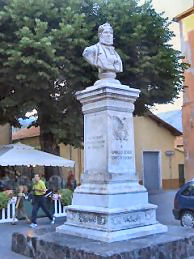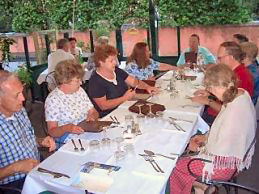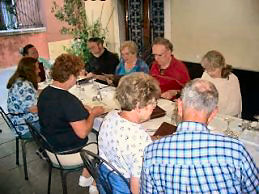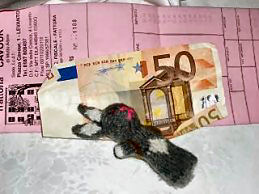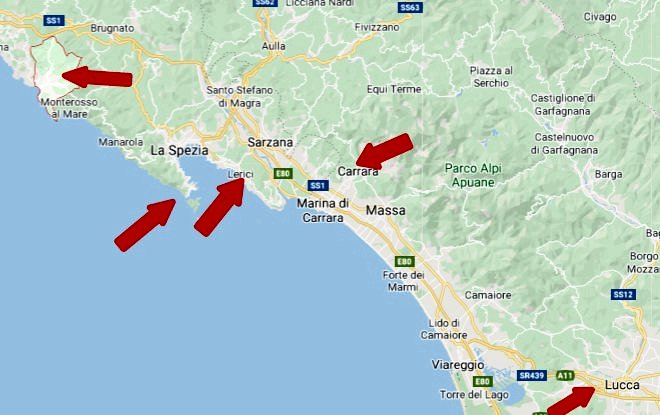
The same wonderful breakfast was served at 7:30. The bus was not scheduled to leave until ten. I worked on my journal for a little while, and then somehow the extra time seemed to disappear into the ether.
From Lucca Mario drove us up the Tuscan coast to Carrara. Here we picked up our local guide, Nicola (accent on second syllable). He explained that he was a professional guide for the provinces of Massa Carrara and La Spezia, which included both Carrara and the Cinque Terre.
The mountains around Carrara, which are called the Apuan Alps, are not as old as the Apennines. They are only 200 million years old. They have been mined since the Roman times. The marble that they contain is almost pure calcium carbonate. Nicola told us that it had an unusually fine grain, and it ranges in color from white to grey. Ninety-five percent of it is white marble. It is the best marble in the world for sculpting statues, not just for its startling appearance but also because its very fine grain is much easier for a sculptor to work with than marble from other locations. The best works of Michelangelo Buonarotti – the Pietà, the David, etc., were done in Carrara marble. In the 16th century he would often come up to Carrara to pick out the blocks for himself.
Nicola began by explaining the economics of marble extraction. The quarries were the property of the city, although 10 percent are private because they were sold in the 1750ís. In 2005 the marble is cut into slabs two centimeters thick using steel cables with industrial diamonds and water. The city had imposed a tax of 4€ per ton on the marble that is removed from the quarries in this way. The tax on debris, which was ground into dust and used in processes like the making of paper, was only half as high. Therefore it had ironically become more profitable to sell debris rather than marble.
The mountains were only approximately six kilometers from the sea. The highest point was Mt. Pisanino, which is about six thousand feet high. The marble was very shallow, only about eighteen inches from the surface. The forests between the mountains and the sea contained mostly (edible) chestnut trees and figs. They also produce a good number of porcini mushrooms.
For centuries the marble was transported by oxen using sledges made of chestnut wood and hemp ropes and lubricated with fat. The railroad was constructed in 1870, and it was used for ninety-six years. It worked fine, but it was difficult to get the marble to the train depot. Since 1966 trucks have replaced the train because they can drive right into the mines. The city allows eight hundred trucks on the mountain per day. The biggest problem is trying to keep the roads in shape. Three mining areas (which Nicola referred to as "basins") are now open – Collonnata, Fantiscritti, and Michelangelo.
We drove through a long one-way tunnel with no lighting whatever. Nicola said that he understood why there were no lights, but that it was difficult to explain. The darkness did not bother Mario a bit.
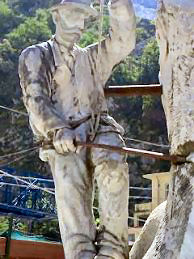
The climb up to the mining areas was steep and treacherous. Finally we arrived at our destination, which was the outdoor museum. The different roles in different ages of mining were cleverly illustrated by statues in marble. I really liked the statues of two men near the entrance. Il Quadratore, who in olden days squared the blocks of marble, was no longer necessary with more modern mining techniques. Workers still played the role of Il Techiaialo in 2005. His job was to swing around on a rope in the mine looking for unsafe sections. He then worked at them with hand tools to make them safe for the other workers.
In ancient times, the blocks were split with wedges made of fig. The wood would absorb a lot of water and expand when it was wet. Hand saws were used until the 1930ís. They were replaced with metal cables using water for cooling and cleaning and silica dust for friction. This method allowed them to cut faster, but still only two to three inches per day. In 2005 they were using tungsten carbide cables and industrial diamonds instead of silica. The new method can cut ten inches per hour.
Nicola explained that they use metallic ďpillowsĒ to extract the blocks. I could not visualize how this could possibly work, but I could not think of a way to phrase the question.
The largest monolith of marble ever extracted was commissioned from Carrara by Mussolini in 1929. After the block was removed, it took seven months to deliver it to Rome, where it has been housed ever since in the Foro Italico. The stone and the sledge together weighed 460 tons.
It is hard to believe, but Nicola said that thin white Carrara marble was translucent.
The visit to Carrara was informative and, at least to me, interesting. Nicolaís English was understandable, but, more than any of the other guides that we have so far had the privilege to listen to, he used literal translations of idiomatic Italian. His delivery was not too dynamic either. Furthermore, the weather was pretty hot, and it was difficult to find relief. Once again – ohimè! – the natives were beginning to get restless.
Nina had no trouble calming them because the next scheduled stop was the stunningly beautiful port town of Lerici. We had a long walk from the bus past hundreds of boats moored in the marina to the shady spot in the waterside park that Nina had chosen for our picnic. I was afraid that Sue might have trouble making the hike, but she came through with flying colors. As usual Nina had laid out an incredible spread. This time it included focaccia, prosciutto, rice with peas, olives, fruit, cookies, and I donít know what else. What did we have to drink? Let me think. Oh yeah, wine.
I was very hungry, but somehow I ended up at the end of the chow line. I downed several thousand olives while I waited in line. I was also about the last person to finish lunch.
We had less than an hour after lunch to see Lerici. I decided to concentrate on the wet part. Sue agreed to watch my pack and money belt. I scrambled down on the rocks to the place where Dorothy and Ruth Abad were already swimming. I had deliberately worn my running shorts under my pants for just this occasion. I took off my shirt, my pants, my shoes, my socks, and my glasses. I went in, got my head wet, and got out. It was not horribly cold, but swimming has never been my thing. The water was very salty, but I liked the feel of the warm sun on my wet body.
Whoops. I forgot to take off my watch.
Sue was weighing the possibility of going swimming, and I agreed to watch her stuff while I dried out in the sun. However, she never got around to going in. By our scheduled departure time of 2:30 I was pretty much dry, so I put my shorts and shirt back on.
Sue and I were a little worried that Patti and Tom were going to miss the boat. They had gone over to see the huge fortress and were the last ones to arrive back at the marina.
We all took the boat to Portovenere, the town that is just south of the Cinque Terre by sea. I sat in the front section and had a very good view. Some English tourists were the only other people in the forward section.
Nina gave us some time to explore Portovenere before catching the boat that went north and stopped at all five towns in the Cinque Terre. Sue and I started and pretty much ended our exploration in a cafť that sold gelato. They had no pistacchio, so I got lemon. Hers had strawberries and pine nuts. She wanted to sit in the cafť, which greatly increased the price of her gelato. No one got on my case for bringing my coppa over to her table. A large number of German or Austrian tourists carrying walking sticks soon joined us. They had evidently just descended from trail #1, the long high trail that connects Levanto with Portovenere. I wondered how much of it they had walked. It was only 3 p.m., and the trail is forty kilometers long and ascends eight hundred meters. Furthermore, they did not seem especially winded. I deduced that they must have started in Riomaggiore or Manarola.
Tom decided to climb the tower in Portovenere, but I didnít feel like it. Instead I spent most of my time trying to read my Italian book on a bench in the sun. I also did a bit of people-watching. Lots of children were playing on the beach. Some girls formed a wall of towels around one of their friends so that she could change into a bathing suit. I didnít feel especially tired, but I could hardly keep my eyes open. Maybe it was the sea air.
From Portovenere we took the scenic – and crowded – boat ride up the coast to the Cinque Terre and our ultimate destination, Levanto, the town just north of the Cinque Terre. This time we had little choice but to sit on the wrong side of the boat. The best views of the harbor towns were from starboard, but I think that I nevertheless snapped some pretty good pictures from the port side. Most of the Germans whom we had seen in Portovenere were also on the boat. They all got off in either Riomaggiore or Manarola.
Patti was taken with the ďLizard PeopleĒ who were out sunbathing on the large white rocks near Riomaggiore. The town, like most Italian seaside communities, does not have anything that resembles a beach.
Everybody was amazed at the scenery surrounding the five villages. I had never seen it from the sea, but I already had a good mental picture of how it must look.
Levanto seemed at least as nice as any of the Cinque Terre towns when we approached it from the water. It was obviously a real town with real hotels. Moreover, it even had a real beach.
The walk from the dock in Levanto to our hotel, the Albergo Primavera, was a short one. We were greeted by the owner, Carlo, with wine and chips to be enjoyed in the hotelís lounge. What a great idea! It really made us feel welcome. The rooms were nice, too. Sue and I were assigned room #102; Tom and Patti were in 106. Each room had a balcony, which almost everyone immediately converted into a clothes-drying place. Our length of twine perfectly matched the width of the balcony. This was certainly a much better way to see the Cinque Terre than to stay at that place in Vernazza with which Rick Steves seemed to be so enamored.
The last laundry in the sink was the easiest washing of the tour. I only had to wash enough things to get me through three days – hiking, the drive to Milan, and the travel day. At some point in the trip I had gotten a tiny spot of olive oil on my shirt. After a few minutes of capillary action it had grown as large as a silver dollar. I tried to remove it with some spot removers that Patti had brought with her, but I had not been successful. Washing didnít help either.
We decided to make an event of dinner. Sue took on the assignment of making reservations for ten or eleven people. Bob couldnít decide whether he wanted to join the party, which consisted of the two of us, Patti and Tom, the Doggetts, the Churchills, and Jan and Barb. The eleventh was Bob. Sue had found a great place named the Trattoria Cavour. Although it was only about two blocks from our hotel, Sue somehow got lost coming back. Even so we made it to the restaurant just in time for our 7:00 reservation. At the last minute Bob decided not to join us.
We all sat at one table outside. The weather was ideal for this. Most of us had pesto of one kind or another. I also had an antipasto of anchovies with lemons. They were to die for. The pesto was good, but, frankly, not that much better than what you get in the Contadina containers. I had to do quite a bit of translating; the waitress did not speak any English at all. One interesting aspect of the service was that the food was served family style. For example, Sue and Tom ordered the same pesto that I ordered. It came in one big bowl, which we had to pass around.
Everybody seemed to have a splendid time at dinner. The food was great, the weather was great, the conversation was great, and it was a genuine bargain at 17€ per person. The people who did not get appetizers or desserts only had to pay 15€. Bill gave me 20€ to pay for himself and Cecile. He insisted that he didnít need any change. I think he was a little embarrassed when I informed him that he owed us another 10€.
We also saw Sandy, Bonnie, Dorothy, and Ruth Abad. They had dined together inside the restaurant. So, fourteen of the twenty-three tour members ate supper at this one restaurant. I doubt that anyone complained.
I went to bed right after supper. I had been looking forward to the planned hike in the Cinque Terre ever since we left the area in May of 2003. I had enjoyed the hike that year on the four seaside trails, but I wanted to try part of the Alta Via, otherwise known as trail #1. It was forty kilometers in length, from Levanto all the way past all five villages of the Cinque Terre to Portovenere. Tom had agreed to accompany me, and Bob asked to join us, too. I decided that it was reasonable to plan to walk to the spot above the second town from us, Vernazza, which is where we stayed last time. Bob informed us that he had located the trailhead. I had a good map. What could possibly go wrong?
Notes: My watch seemed to have survived the swim.
I have noticed that the other couples in the group seemed to spend almost all of their time together. At the community meals they always sit next to one another. To some extent this was the case two years ago as well. I canít imagine spending all day with Sue. Our paces sof living are so different that we would make each other miserable. Furthermore, Sue and I eat supper together every evening all year long. If we sat next to each other at every meal on vacation, there would be one less person for each of us to get to know each time. Finally, doubling our experiences gives us that much more to talk about both on the vacation and afterwards.
Sue convinced Jan and Barbara to join her for breakfast at Il Pirata Delle Cinque Terre in Vernazza on Friday. This seemed like a loony plan to me. The hotel offered a free breakfast. Getting to Vernazza required catching a train, which in our experience ran on flexi-time. There was definitely no guarantee that Il Pirata would actually have the pastries that Sue enjoyed last time (but was unable to get the second day). This was a good example of why it sometimes seemed a good idea to split up.
I have been a little disappointed with the pesto in my two trips to the land that is the source of the dish, Liguria. I have enjoyed it, but the difference between what you can get here and what you can get at the grocery store seemed to be much less than for other foods. For example, the seafood in Italy has seemed uniformly fantastic to me. I almost never eat seafood in New England.
It was hot and clear all day. The weather has been eerily reminiscent of 2003. The only significant rain that we have encountered at any point on the tour was in Montone and its environs.
